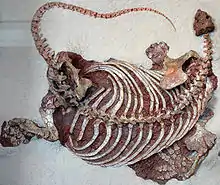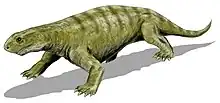| Caseasaurs Temporal range: Late Carboniferous-Late Permian, | |
|---|---|
 | |
| Fossil skeleton of Cotylorhynchus romeri | |
| Scientific classification | |
| Domain: | Eukaryota |
| Kingdom: | Animalia |
| Phylum: | Chordata |
| Clade: | Synapsida |
| Clade: | †Caseasauria Williston, 1912 |
| Families | |
Caseasauria is one of the two main clades of early synapsids, the other being the Eupelycosauria. Caseasaurs are currently known only from the Late Carboniferous and the Permian, and include two superficially different families, the small insectivorous or carnivorous Eothyrididae, and the large, herbivorous Caseidae. These two groups share a number of specialised features associated with the morphology of the snout and external naris.
The ancestor of caseasaurs can be traced back to an insect eating or an omnivorous reptile-like synapsid from the Pennsylvanian time of the Carboniferous, possibly resembling Archaeothyris, the earliest known synapsid. The caseasaurs were abundant during the later part of the Early Permian, but by the Middle Permian caseasaur diversity declined because the group was outcompeted by the more successful therapsids. The last caseasaurs became extinct at the end of the Guadelupian (Middle Permian).
Description
Among the most conspicuous characteristics uniting caseasaurs are an enlarged nostril and a snout tip that overhangs the tooth row.[1]
Early caseasaurs, including all eothyridids, were relatively small animals. However, most caseids reached larger sizes, and some caseids, such as Cotylorhynchus and Alierasaurus, were among the largest terrestrial animals of the early Permian. These large herbivorous taxa reached a length of 4 to 6 meters (13 to 20 ft) and a mass of 330 to 500 kilograms (730 to 1,100 lb).[2]
Evolution
Caseasaurs first appear in the fossil record in the late Carboniferous, alongside many other early amniote groups. The earliest known synapsid, Asaphestera from the Bashkirian age, may be an eothyridid caseasaur.[3] The earliest definitive caseasaur is Eocasea.[4]
Caseids thrived during the Kungurian age, and numerous large herbivorous caseids are known from the Kungurian of the United States.
Caseasaurs are one of the two synapsid clades known to have survived into the Guadalupian epoch, along with varanopids. Two caseasaur taxa are known from the Guadalupian of Russia, representing the geologically youngest known caseasaurs: the small, possibly omnivorous or insectivorous Phreatophasma, and the large, herbivorous Ennatosaurus.[5]
Classification
| ||||||||||||||||||||||||||||||||||||||||||||||||||||||
| Phylogenetic position of Caseasauria within Reptiliomorpha, showing the possible alternate positions of Diadectomorpha. Varanopidae may belong to Sauropsida. |
Caseasauria is generally regarded as the most basal clade of synapsids, with all other synapsids being grouped in the clade Eupelycosauria. However, not all studies have supported this position. In 2012, Roger Benson argued that most of the characters supporting a basal position for caseasaurs pertained to the skull, and presented a phylogenetic analysis incorporating more postcranial data that resolved a clade comprising ophiacodontids and varanopids as the basalmost synapsid clade.[6] However, new postcranial data from eothyridids and basal caseids established that caseasaurs were more basal than ophiacodontids and varanopids after all, with the characters supporting a more derived position for caseasaurs being the result of convergent evolution between caseids and more derived synapsids.[4][7] The diadectomorphs, conventionally regarded as anamniote tetrapods, may prove to be synapsids even more basal than Caseasauria.[8][9]
| |||||||||||||||||||||||||||||||||||||||||||||||||||
| Phylogeny of Caseidae, after Berman et al. 2020[10] |
Most caseasaurs are divided into two families, Eothyrididae and Caseidae. The affinities of the earliest definitive caseasaur, Eocasea, are uncertain, with some phylogenetic analyses finding it to be a caseid and others finding it to be a basal caseasaur belonging to neither family.[11][12]
Three genera are typically regarded as belonging to the family Eothyrididae: Eothyris, Oedaleops, and Vaughnictis. However, some phylogenetic analyses have failed to resolve the eothyridids as a clade, instead finding them to be paraphyletic with respect to Caseidae.[13][11] Asaphestera has been provisionally regarded as an eothyridid as well, without being included in a phylogenetic analysis.[14]
The remaining caseasaurs belong to the family Caseidae.
List of species
| Genus | Species | Year Named | Family | Age | Location | Notes |
|---|---|---|---|---|---|---|
| Eocasea | E. martini | 2014 | incertae sedis | Gzhelian | May be a caseid | |
| Asaphestera | A. platyris | 1934 | Eothyrididae | Bashkirian | Synapsida incertae sedis; may be an eothyridid | |
| Eothyris | E. parkeyi | 1937 | ||||
| Oedaleops | O. campi | 1965 | ||||
| Vaughnictis | V. smithae | 1965 | Asselian–Sakmarian | Originally assigned to the genus Mycterosaurus | ||
| Callibrachion | C. gaudryi | 1893 | Caseidae | |||
| Datheosaurus | D. macrourus | 1904 | ||||
| Oromycter | O. dolesorum | 2005 | ||||
| Phreatophasma | P. aenigmatum | 1954 | Roadian | |||
| Martensius | M. bromackerensis | 2020 | ||||
| Ruthenosaurus | R. russellorum | 2011 | ||||
| Casea | C. broilii | 1910 | ||||
| C. halselli | 1954 | |||||
| C. nicholsi | 1954 | |||||
| Euromycter | E. rutenus | 1974 | Originally described as Casea rutena | |||
| Ennatosaurus | E. tecton | 1956 | The geologically youngest known caseasaur | |||
| Caseopsis | C. agilis | 1962 | ||||
| Caseoides | C. sanangelensis | 1953 | ||||
| Arisierpeton | A. simplex | 2019 | ||||
| Alierasaurus | A. ronchii | 2014 | ||||
| Cotylorhynchus | C. romeri | 1937 | ||||
| C. hancocki | 1953 | |||||
| C. bransoni | 1962 | |||||
| Angelosaurus | A. dolani | 1953 | ||||
| A. greeni | 1962 | |||||
| A. romeri | 1962 | |||||
| Trichasaurus | T. texensis | 1910 | ||||
Paleoecology
The paleoecology of caseids is debated. They are typically interpreted as terrestrial animals of dry, upland habitats. However, Caseids exhibit a similar bone microstructure to cetaceans and pinnipeds, which has led to the hypothesis that they led an aquatic lifestyle.[15][16] This hypothesis has been challenged on the grounds that their bone microstructure specifically resembles fully pelagic animals, and is unlike the bone microstructure of semiaquatic animals, but that the body plan of caseids is inconsistent with a pelagic lifestyle.[16] Moreover, caseid fossils are predominantly associated with arid upland deposits.
See also
References
- ↑ Angielczyk & Kammerer 2018, p. 125.
- ↑ Angielczyk & Kammerer 2018, p. 127.
- ↑ Mann et al. 2020, p. 15.
- 1 2 Reisz & Fröbisch 2014.
- ↑ Brocklehurst & Fröbisch 2017.
- ↑ Benson 2012.
- ↑ Brocklehurst et al. 2016.
- ↑ Marjanović & Laurin 2019.
- ↑ Klembara et al. 2021.
- ↑ Berman et al. 2020.
- 1 2 Spindler et al. 2018.
- ↑ Ford & Benson 2020.
- ↑ Sumida, Pelletier & Berman 2014, pp. 20–21.
- ↑ Mann et al. 2020.
- ↑ Lambertz et al. 2016.
- 1 2 Angielczyk & Kammerer 2018, p. 128.
Bibliography
- Angielczyk, Kenneth D.; Kammerer, Christian F. (2018-10-22). "Non-Mammalian synapsids: the deep roots of the mammalian family tree". Mammalian Evolution, Diversity and Systematics. De Gruyter. pp. 117–198. doi:10.1515/9783110341553-005. ISBN 978-3-11-034155-3. S2CID 92370138.
- Benson, R.J. (2012). "Interrelationships of basal synapsids: cranial and postcranial morphological partitions suggest different topologies". Journal of Systematic Palaeontology. 10 (4): 601–624. doi:10.1080/14772019.2011.631042. S2CID 84706899.
- Berman, David S; Maddin, Hillary C.; Henrici, Amy C.; Sumida, Stuart S.; Scott, Diane; Reisz, Robert R. (2020-03-31). "New Primitive Caseid (Synapsida, Caseasauria) from the Early Permian of Germany". Annals of Carnegie Museum. 86 (1): 43. doi:10.2992/007.086.0103. ISSN 0097-4463. S2CID 216027787.
- Brocklehurst, Neil; Fröbisch, Jörg (2017-02-21). "A re-examination of the enigmatic Russian tetrapod Phreatophasma aenigmaticum and its evolutionary implications". Fossil Record. 20 (1): 87–93. doi:10.5194/fr-20-87-2017. ISSN 2193-0074.
- Brocklehurst, Neil; Reisz, Robert; Fernandez, Vincent; Fröbisch, Jörg (2016). "A Re-Description of 'Mycterosaurus' smithae, an Early Permian Eothyridid, and Its Impact on the Phylogeny of Pelycosaurian-Grade Synapsids". PLOS ONE. 11 (6): e0156810. Bibcode:2016PLoSO..1156810B. doi:10.1371/journal.pone.0156810. PMC 4917111. PMID 27333277.
- Ford, David P.; Benson, Roger B. J. (2020). "The phylogeny of early amniotes and the affinities of Parareptilia and Varanopidae". Nature Ecology & Evolution. 4 (1): 57–65. doi:10.1038/s41559-019-1047-3. ISSN 2397-334X. PMID 31900445. S2CID 209673326. Retrieved 2020-02-07.
- Klembara, Jozef; Ruta, Marcello; Hain, Miroslav; Berman, David S. (2021). "Braincase and Inner Ear Anatomy of the Late Carboniferous Tetrapod Limnoscelis dynatis (Diadectomorpha) Revealed by High-Resolution X-ray Microcomputed Tomography". Frontiers in Ecology and Evolution. 9. doi:10.3389/fevo.2021.709766. ISSN 2296-701X.
- Lambertz, M.; Shelton, C.D.; Spindler, F.; Perry, S.F. (2016). "A caseian point for the evolution of a diaphragm homologue among the earliest synapsids". Annals of the New York Academy of Sciences. 1385 (1): 3–20. Bibcode:2016NYASA1385....3L. doi:10.1111/nyas.13264. PMID 27859325. S2CID 24680688.
- Mann, Arjan; Gee, Bryan M.; Pardo, Jason D.; Marjanović, David; Adams, Gabrielle R.; Calthorpe, Ami S.; Maddin, Hillary C.; Anderson, Jason S. (2020). "Reassessment of historic 'microsaurs' from Joggins, Nova Scotia, reveals hidden diversity in the earliest amniote ecosystem". Papers in Palaeontology. 6 (4): 605–625. doi:10.1002/spp2.1316. ISSN 2056-2802. S2CID 218925814.
- Marjanović, David; Laurin, Michel (2019-01-04). "Phylogeny of Paleozoic limbed vertebrates reassessed through revision and expansion of the largest published relevant data matrix". PeerJ. 6: e5565. doi:10.7717/peerj.5565. ISSN 2167-8359. PMC 6322490. PMID 30631641.
- Reisz, Robert R. (1986). Pelycosauria. Handbuch der Paläoherpetologie. Stuttgart; New York: Gustav Fischer Verlag. ISBN 978-3-437-30486-6.
- Reisz, Robert R.; Fröbisch, Jörg (2014). "The Oldest Caseid Synapsid from the Late Pennsylvanian of Kansas, and the Evolution of Herbivory in Terrestrial Vertebrates". PLOS ONE. 9 (4): e94518. Bibcode:2014PLoSO...994518R. doi:10.1371/journal.pone.0094518. PMC 3989228. PMID 24739998.
- Spindler, Frederik; Werneburg, Ralf; Schneider, Joerg W.; Luthardt, Ludwig; Annacker, Volker; Rößler, Ronny (2018). "First arboreal 'pelycosaurs' (Synapsida: Varanopidae) from the early Permian Chemnitz Fossil Lagerstätte, SE Germany, with a review of varanopid phylogeny". PalZ. 92 (2): 315–364. doi:10.1007/s12542-018-0405-9. eISSN 1867-6812. ISSN 0031-0220. S2CID 133846070.
- Sumida, Stuart S; Pelletier, Valerie; Berman, David S. (2014). "New Information on the Basal Pelycosaurian-Grade Synapsid Oedaleops". In Kammerer, Christian F.; Angielczyk, Kenneth D.; Fröbisch, Jörg (eds.). Early Evolutionary History of the Synapsida. Dordrecht: Springer Netherlands. pp. 7–23. doi:10.1007/978-94-007-6841-3_2. ISBN 978-94-007-6840-6.





.jpg.webp)